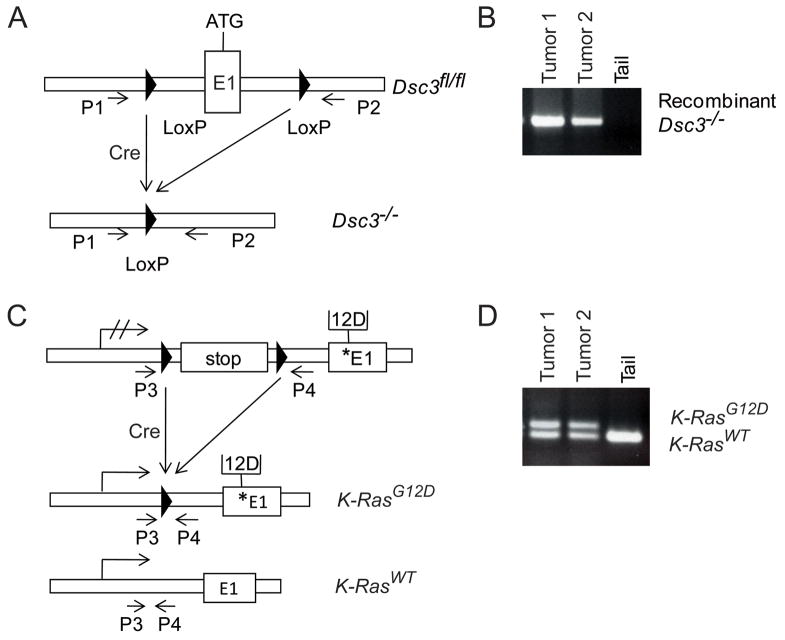Figure 1.
Generation of an animal model to study the role of Dsc3 in skin tumorigenesis. A conditional Dsc3 null allele (Dsc3 fl/fl; [8]) was introduced into a mouse line carrying a conditional oncogenic K-RasG12D allele [17]. Inducible expression of Cre recombinase (K5.Cre*PR1 transgene; [18]) in the basal layer of mutant (Dsc3fl/f; K-RasG12D; K5.Cre*PR1) epidermis leads to Dsc3 ablation (Dsc3−/− alleles) and K-RasG12D activation. Note that the Cre recombinase is only active after topical application of the inducer RU486. (A) Schematic representation of the 5′ end of the Dsc3 gene. LoxP sites (triangles) were inserted in the proximal promoter and in the first intron of the gene (ATG demarcates the start codon in exon 1). Cre-mediated recombination leads to the excision of promoter elements and exon 1, rendering the gene nonfunctional. Successful recombination between the loxP sites can be detected with primers P1 and P2, which amplify a DNA fragment only after successful deletion of the floxed sequence (see [8] for details). (B) PCR analysis of genomic DNA isolated from two RU486-induced Dsc3fl/f; K-RasG12D; K5.Cre*PR1 tumors (Tumor 1, Tumor 2). Note that both tumors demonstrated successful recombination at the Dsc3 gene locus as demonstrated by the presence of the P1/P2 PCR product. Tail DNA (Tail) from a mutant mouse served as a negative control. Since the tail was not treated with the inducer RU486, recombination did not occur. (C) Activation of the conditional K-RasG12D allele. Cre-mediated recombination removes a stop-flox sequence thus allowing expression of the oncogene from the endogenous promoter. Primers P3 and P4 are used in PCR to distinguish between the activated oncogene and the K-Ras wild type allele. The star demarcates the position of the mutant sequence in Exon 1 (modified from [38]). The arrow with hatched lines symbolizes a silent K-Ras locus, while the arrows without the hatched lines symbolize transcriptionally active loci. (D) The genomic DNA samples used in (B) were subjected to PCR using primers P3 and P4. As expected, the mutant tail DNA only showed the wild type allele whereas the tumor samples showed both the wild type and the recombined (activated) oncogene allele. The size difference between the two products is due to the presence of the LoxP sequence in the product amplified from the recombined locus.

